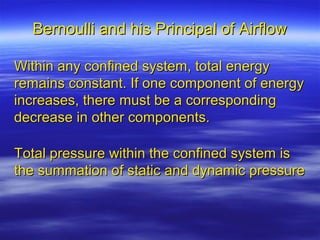Bernoulis principle
- 1. Bernoulli and his Principal of Airflow Within any confined system, total energy remains constant. If one component of energy increases, there must be a corresponding decrease in other components. Total pressure within the confined system is the summation of static and dynamic pressure
- 2. Venturi Tube (subsonic, incompressible flow) The volume of air passing any given point per unit of time is equal throughout the tube. This is known as MASS FLOW RATE Slow velocity of air with As air velocity increases, equal static and equal static and static pressure decreases, dynamic pressures dynamic pressures dynamic pressure increases
- 3. Airfoil Lets take half of that venturi tube and see what happens when we move air across the shape Lets assume there is no upper physical limit of the tube The flow closest to the airfoil conforms to the shape of the airfoil while the air farthest from the airfoil remains horizontal and acts like the upper surface of the venturi
- 4. How is most of the lift produced? Since air has a greater distance to travel over the upper surface there is a greater velocity increase and pressure decrease over the upper surface than the lower surface. The higher pressure below the airfoil seeks the lower pressure above causing the airfoil to move up. Low Pressure Area Static =1 Static =5 =9 = 10 Dynamic = 8 Dynamic = 5 Static =4 = 10 Dynamic = 6 Static =4 = 11 High Pressure Area Dynamic = 7 High seeks Low
- 5. Question If the differential in pressures produces most of the lift, what is producing the rest of the lift? The remaining lift is a result of Newton’s third law of motion, Action and Reaction
- 6. Questions?






